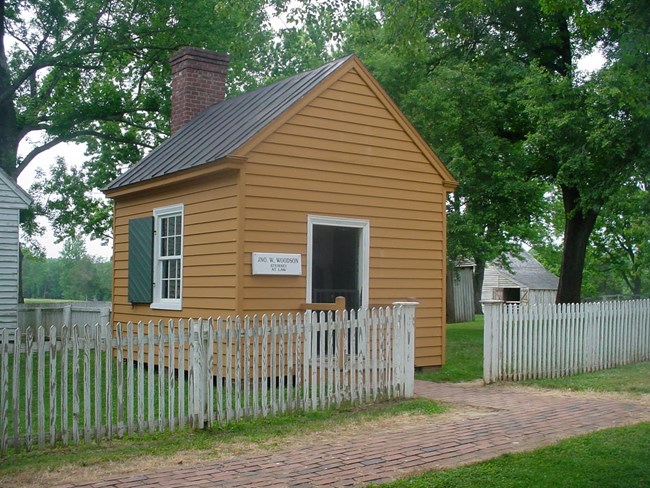
McLean HouseThe building was originally constructed by Charles Raine as a tavern in 1848, and was purchased by Wilmer McLean in 1863. It was the site of Lee's surrender to Grant on April 9, 1865. In 1893, the building was dismantled in an abortive, privately funded attempt to exhibit it at the World's Columbian Exposition in Chicago; its structural members were to be re-assembled in Washington, D.C., to house a Civil War museum. It was reconstructed on its original site beginning in 1948, and was dedicated on April 16, 1950, with Robert E. Lee IV and General Ulysses S. Grant III as guests of honor. It was restored in 1998. Originally constructed in 1848, the well house, encased in latice work in front of the house, was reconstructed in 1950, and preserved in 1995. 
McLean Summer Kitchen and Slave QuartersBoth structures were originally constructed in 1848, and reconstructed in 1965. Both are open to public viewing, including exhibits in the rear of the summer kitchen. 
Appomattox County CourthouseThe original courthouse was constructed in 1846, one year after Appomattox County was established. The courthouse played no role in Lee's surrender; it was closed on April 9, 1865 (as it was Palm Sunday). In 1892, the building burned, and citizens voted to move the county seat to nearby Appomattox Station (present day Appomattox). The existing building was reconstructed in 1963-64 to function as the park visitor center. The courthouse received further attentions in 1986, 1995, and 2001. 
Clover Hill TavernThe tavern was built by Alexander Patteson in 1819 for travelers on the Richmond-Lynchburg Stage Road and was restored in 1954. The building houses a representative exhibit of the printing of thousands of parole passes for the surrendered Confederate soldiers. 
Clover Hill Tavern Kitchen and Guest HouseThe two-story tavern kitchen and three-story guest house were built in 1848 and was restored in 1953 and 1997. 
Meeks StoreThe building was constructed in 1852 by John H. Plunkett and was purchased in the early 1860s by Francis Meeks, who served as the local postmaster and druggist. It was later the home of a Presbyterian minister who presented it to his church for use as a manse. While a store, the building was one of the social centers of village life. It was restored in 1959 and 1983. The first floor interior is interpreted as a general store and post office.
Meeks StorehouseConstructed circa 1850 by John Plunkett, this one-story structure was relocated slightly on the property, restored in 1959, and preserved in 1998. Meeks StableConstructed circa 1850 and reconstructed in 1949. 
NPS Kelley HouseFrom the porch of this house the residents may have watched Lee's Confederates lay down their arms on April 12, 1865. The house was first built by carpenter Lorenzo Kelley in 1855. His mother Elizabeth "Widow Kelley" and grandmother Priscilla Staples lived there with the five Kelley sons who served in the Confederate Army (two died, one deserted and two were present for the surrender). 
Woodson Law OfficeThis has been interpreted as the law office of John W. Woodson. The office is original and was restored in 1959 and 1985. The building is plainly furnished and is typical of the country lawyers' offices found in Virginia county seats of the period. 
Appomattox County Jail (New Jail)The New County Jail is directly across the Richmond-Lynchburg Stage Road from the site of the first county jail. Begun about 1864, but not completed until after the Civil War in 1868. From 1868 until the county seat was moved in 1892, the building served its original function. From 1892-1940, the building was used as the polling station for the Clover Hill magisterial district.
Isbell HouseBrothers Thomas S. and Henry F. Bocock built this house in 1849-50. Thomas served as a member of the U.S. Congress and as Speaker of the Confederate House of Representatives, and Henry was Clerk of the Court for Appomattox County from 1845 to 1860. Lewis Isbell, the Commonwealth Attorney for Appomattox County during the Civil War, lived in the house in 1865. The building was restored in 1948-49 and received further treatment in 1992, 1995, and 1999. The Isbell House now serves as Park Headquarters and is not open to the public. 
Peers HouseThis frame house was built by 1855, when a Mr. McDearmon sold it to William Abbitt, who sold it to D.A. Plunkett in 1856. George Peers, clerk of the court for Appomattox County for 40 years, lived there at the time of the Lee's surrender. Peers bought the house at public auction after Plunkett's death in 1870. It was restored in 1954 and 2019 and is not open to the public. |
Last updated: April 26, 2025
